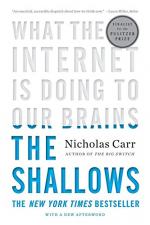
|
| Name: _________________________ | Period: ___________________ |
This test consists of 15 multiple choice questions and 5 short answer questions.
Multiple Choice Questions
1. What device does Carr buy in 1990 that increases his ability to connect to the nascent Internet?
(a) A cyber-optic cable connector.
(b) A Hypercard.
(c) A modem.
(d) An external hard drive.
2. Which was one of the first computers Carr ever bought for his own personal use?
(a) One of Toshibia's early laptops.
(b) One of IBM's earliest desktops.
(c) One of Apple's earliest Macintoshes.
(d) An early Apple Smartphone.
3. What did the creation of word breaks and punctuation do for readers as the act of writing evolved, according to Carr?
(a) Readers became more receptive to having their children learn to read.
(b) Readers became more efficient and more attentive.
(c) Readers became more likely to want to attend the theater.
(d) Readers became more likely to also want to listen to music as they were reading.
4. Which media mogul at RCA and NBC dismissed criticism of the mass media on which his career was built in the year 1955?
(a) David Sarnoff.
(b) Walter White.
(c) Les Moonves.
(d) Walter Winchell.
5. What does the researcher Nicole Speer say about the act of deep reading?
(a) It is only achievable with absolute silence.
(b) It is not passive, but rather very active.
(c) It is a prerequisite for academic achievement.
(d) It is not possible for many people to focus long enough to read deeply.
6. How many categories does Carr claim our technologies can be divided into in Chapter Three?
(a) 7.
(b) 4.
(c) 8.
(d) 2.
7. Which university was at the forefront of computer programming and technological advances in the late 1970s, according to Carr?
(a) Florida State University.
(b) Penn State University.
(c) Harvard University.
(d) Dartmouth University.
8. In Chapter Three, what does Carr posit is one way to trace the intellectual maturation of individuals?
(a) Through the way people draw pictures or maps of their surroundings.
(b) Through how quickly people can do multiplication tables.
(c) Through how many languages people speak.
(d) Through assessing a person's emotional intelligence.
9. In Chapter Four, who does Carr claim were the first people to use a specialized medium for writing?
(a) The Sumerians.
(b) The Greeks.
(c) The Arabs.
(d) The Europeans.
10. According to Carr, what did the widespread use of clocks do for civilization?
(a) Helped people keep Seasonal Affective Disorder in check.
(b) Helped people stop missing appointments.
(c) Helped people maximize their productivity in terms of farming and harvesting food.
(d) Helped move societies from agrarian ones to more urban, higher-tech ones.
11. Where did Lee de Forest grow up?
(a) Mississippi.
(b) Louisiana.
(c) Pennsylvania.
(d) Alabama.
12. What was one of the main drawbacks to scrolls?
(a) They were expensive.
(b) They were fragile.
(c) They were only used by the poorest people.
(d) There was never enough ink to use on the scrolls.
13. What else besides repeated physical actions can rewire the human brain?
(a) Purely mental activity.
(b) Having and walking a dog every day.
(c) Herbs and spices.
(d) Direct exposure to bright sunlight.
14. Who created the Hypercard application?
(a) Harry Prevnar.
(b) Charles Lightner.
(c) Bill Atkinson.
(d) James Jamison.
15. In Chapter Three, what does Carr say Theuth thought about the art of writing?
(a) He thought it would make Egyptians wiser and improve their memories.
(b) He thought it would lead to uprisings against the ruling classes.
(c) He thought it would lead people to more secular lives.
(d) He thought it would lead to unrest among the farmers.
Short Answer Questions
1. In what year does Carr say he starts to have reservations and misgivings about how his time spent online is affecting him?
2. Which alphabet became the model for most Western alphabets, according to Carr?
3. Who did Gutenberg secure funding for his printing press from?
4. How did most literate Greek and Romans consume literature in the earliest days of the written word, according to Carr in Chapter Four?
5. According to Carr in Chapter Four, what kind of reading was largely unknown in the ancient world?
|
This section contains 662 words (approx. 3 pages at 300 words per page) |

|




